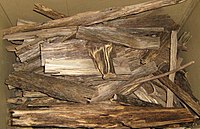
Photo from wikipedia
Aquilaria hirta is one of the agarwood tree species in Malaysia that produces a unique resinous wood and essential oil used in perfumery, medicinal, cosmetic and religious ceremonies. Currently, it… Click to show full abstract
Aquilaria hirta is one of the agarwood tree species in Malaysia that produces a unique resinous wood and essential oil used in perfumery, medicinal, cosmetic and religious ceremonies. Currently, it has been listed as vulnerable (VU) and threatenad species in the IUCN Red List. This study aims to characterize the morphology of A. hirta via scanning electron microscopic analysis, and to identify the volatile chemical compounds of the wood and its essential oil using gas chromatography-flame ionisation detector and gas chromatography-mass spectrometry analyses. Aquilaria hirta was identified by the presence of hirsute on the abaxial side of leaves and midrib. The field emission scanning electron microscope analysis showed plant vessel pits can be seen in the healthy wood images compared with resinous wood images due to presence of resin and microorganisms. A total of 19 compounds were identified in resinous A. hirta wood consisting of 5.97% sesquiterpenes and 20.32% oxygenated sesquiterpenes. The major compounds are kessane, γ-cadinene, α-caryophyllene, β-caryophylene and caryophyllene oxide. There were 35 compounds found in A. hirta oil comprising 0.45% monoterpenes, 23.51% sesquiterpenes and 19.53% oxygenated sesquiterpenes. Major compounds detected were γcadinene, nor-ketoagarofuran, allo-aromadendrene, γ-gurjunene and β-gurjunene. This study provides a reference for the identification of A. hirta species based on morphology evaluation and volatile chemical compounds profile of the essential oil and wood..
Journal Title: Journal of Tropical Forest Science
Year Published: 2020
Link to full text (if available)
Share on Social Media: Sign Up to like & get
recommendations!